Why iTOVi Uses DNA to Maximize Your Wellness Results
Unraveling the structure, function, and importance of DNA has been perhaps one of the most important developments in modern biology.
Individualized DNA analysis has brought great sociological, psychological, medical, and wellness benefits to the world. And while our DNA does not determine our destiny, understanding our DNA can change our futures for the better.
In this resource guide, we’ll cover:
- What is DNA?
- How can iTOVi DNA Help You?
- Discover the Long-Term Foundations of Your Wellness
- How it Works
- Unraveling the Story of DNA
- DNA Under The Microscope
- The Chemistry of DNA
- DNA’s Structure and Storage
- The Functional Role of DNA
- Analyzing DNA:
- What Is The Benefit In Analyzing DNA?
- 1. Health & Wellness
- 2. Genealogical Studies
- 3. Genetic Engineering
- 4. Forensics
- What Is The Benefit In Analyzing DNA?
- How is DNA Analyzed?
- What Are They Looking For?
- How is DNA Analysis Done?
What is DNA?
DNA serves as the “code” for all life.
From single-celled bacteria to the great redwood tree to complex human beings like you, DNA makes it possible for life to exist in all its forms.
DNA = DeoxyriboNucleic Acid.
Physically, DNA is a just molecule, but the unique double-helix structure and behavior of this molecule make it the gateway, protector, and blueprint for all life on earth.
New life begins when DNA is either 1) directly copied via asexual reproduction or 2) shared and mixed between two parent organisms. And in this way, the DNA “code” accounts for all the shared features of a species and all the features that make individuals of a species physiologically distinct from one another.
What’s more, the DNA blueprint helps coach every organism through all its developmental stages, influencing every biological process until the day that that organism dies.
After centuries of searching to understand how the life cycle and genetic inheritance works, scientists can now study and work directly with DNA. And working with DNA has brought great advancements to the fields of genealogy, medicine, and forensics.
In this resource guide, we will explore the fascinating history, structure, and societal significance of DNA, as well as the revolutionary means used to analyze DNA in modern laboratories.
How Can iTOVi DNA Help You?
Discover the Long-Term Foundations of Your Wellness
Your DNA is the blueprint for your body. It lays the foundations, or rules, for your body’s lifelong wellness. And now you can read it! iTOVi DNA allows you to discover the genetic wellness traits in your DNA and build a wellness plan based on who you are!
Our lab analyzes approximately 300 unique genetic markers that have been shown through external research to be related to various ways the human body processes food, nutrients and physical exercise, as well as how the body responds to the aging process.
- You do NOT need to own an iTOVi Scanner to use iTOVi DNA
- Learn about YOUR long-term wellness strengths
- Defend against YOUR long-term wellness vulnerabilities
- Lifetime access to all your DNA Reports, so you can refer back to your reports often
- Customize your wellness plan with products and activities that suit your body’s needs
- Privacy guaranteed!
How it Works
STEP 1: Order your DNA Kit online and we’ll ship it to you. You can start with the iTOVi DNA Kit + Balance Report, or purchase the entire kit including Fitness, Nutrition, and Beauty Reports.
STEP 2: Activate your DNA Kit in the App, and follow the instructions to collect your DNA sample. We use noninvasive swabs to collect cells from the mouth. The swab is easy to use, and it only takes about a minute to collect enough DNA for analysis.
STEP 3: Mail your sample to our lab in the provided pre-labeled, pre-paid envelope.
STEP 4: Our lab will sequence your DNA, identifying the wellness traits present in your genetic code. You will be notified as soon as your report is ready.
Turnaround time from ordering your kit to uploading results is about 4-6 weeks. Your DNA report(s) will be ready to view online. Simply sign in to dna.itovi.com to view your DNA traits along with personalized product and lifestyle suggestions to match!
If you have the iTOVi App your results will also appear in the DNA tab on the Home Screen. If you own an iTOVi Scanner, you will see DNA traits appear in your scans and give suggestions that can help on a more long-term basis.
STEP 5: Your DNA sample will be destroyed by the lab within 45 days of analyzing the DNA. We keep all your information encrypted so only YOU can see it.
Your privacy is protected by the Genetic Information Non-discrimination Act (GINA), which was instituted in the United States in May 2008. As a result, you are also not required to disclose genetic information to an employer or insurer. In addition, iTOVi will not respond to any request for test results from an insurer, employer or any other entity.
STEP 6: Use the information in your report to guide your wellness plans your whole life long! Refer back to your reports whenever you wish!
NOTE: iTOVi DNA is NOT a diagnostic tool. iTOVi focuses solely on those genes that are related to the body’s ability to process food, nutrients and physical exercise. Any DNA test performed to detect predictors for disease should be interpreted by a physician or a certified genetic counselor.
Learn more about how iTOVi DNA can maximize your wellness routines:
- Nutritional Balance & Macronutrients
- Supplements & Nutritional Support from iTOVi
- Creating the Base of an Exercise Plan
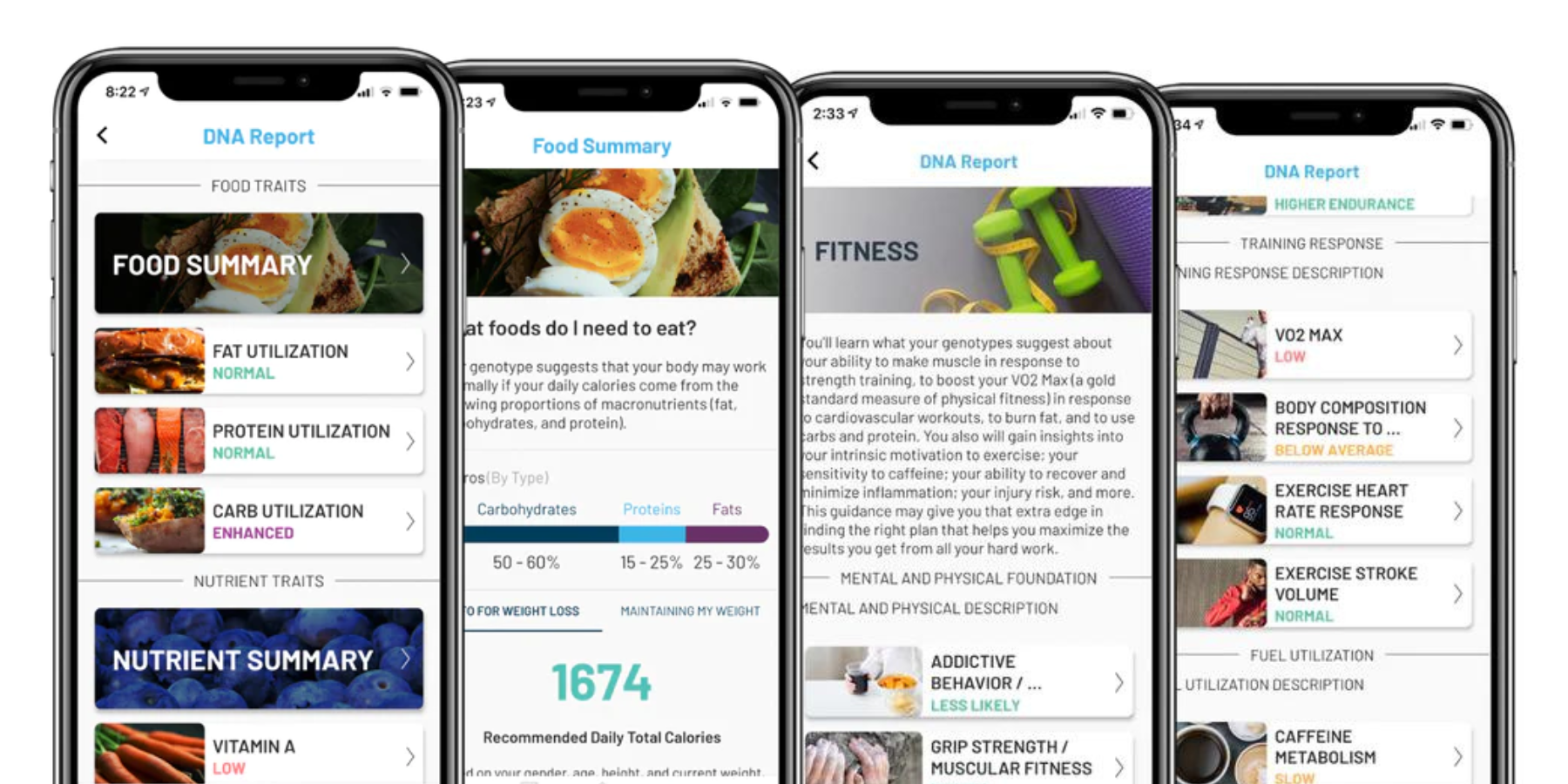
Unraveling the Story of DNA
To understand the history of DNA research, it is helpful to start with the history of genetics.
Genetics: the study of heredity and the variation of inherited characteristics
Mankind has always been aware that something in the reproductive process passes certain traits from a parent to an offspring, be it eye color, height, or even vulnerability to certain
diseases. The theories of Hip- pocrates, Aristotle, and ancient treatises such as the Charaka Samhita all attempted to explain the inheritance of traits. But at the time, with the tools they had, all they could really do was theorize.
The rules of heredity only really started to become clear with the work of Gregor Johann Mendel, an Augustinian friar in what was then the Austrian Empire. Mendel meticulously studied pea plants, cross-breeding different types, and keeping track of the height, shape, and color ratios that appeared in each generation. He even recorded the details of the flower positioning and of the shape and color of the seeds!
Mendel published his theories in 1864, claiming, with his detailed notes, that certain invisible “factors” determined the traits of an offspring organ- ism. His notes suggested that whatever these factors were—they worked predictably within certain mathematical ratios. And in studying these ratios, Mendel concluded that there were certain “dominant traits” and “recessive traits” when it came to genetic inheritance. He could describe the trends he found and theorize about their meaning—but he couldn’t yet explain how all this worked on a mechanical level.
Though Mendel’s Laws of Inheritance were not appreciated by the world during his lifetime, Mendel was convinced of the value of his work.
“My scientific studies have afforded me great gratification; and I am convinced that it will not be long before the whole world acknowledges the results of my work.” —George Johann Mendel
A few years later, however, a Swiss researcher named Friedrich Miescher isolated a new molecule from inside lymphatic cells. The substance was whitish, goopy, and consisted of hydrogen, oxygen, and a unique ratio of phosphorus to nitrogen. Having found this substance in the nucleus of the cells he had been studying, Mieschner decided to call the goo “nuclein” and although he suspected that he had found the molecule of heredity, he died before his theories could be confirmed. In fact, it would take more than a century before scientists could unravel the connection between Meischner’s molecule and Mendel’s research.
Fortunately, the dawn of the 20th century brought with it a slew of achievements in the study of genetics. In 1902, chromosomes (distinct units of DNA in every living organism) were discovered. And just three years later, scientists confirmed that the X and Y chromosomes were correlated to gender. What else could these nuclein chromosomes do?
By 1925, the Mendelian model for genetic inheritance had been widely accepted, but it wasn’t until Oswald Avery’s experiments in 1944 that nuclein, or “DNA” was confirmed to be the “invisible factor”—the key to genetic inheritance—that scientists had been looking for. Not only was Mendel right, scientists now had the tools they needed to figure out why. With that, scientists scrambled to deepen their understanding of the DNA molecule, especially its structure. They knew what the DNA molecule was made out of, but they didn’t know how those pieces came togeth- er to form such a vital molecule that per- formed such vital functions.
A race broke out between various researchers and universities to see who could determine the structure of DNA first and the race ended in 1953—with three articles published together from Cambridge and King’s College in the scientific journal Nature. Together these articles described the double-helix structure of DNA. Just a few decades later, recurring markers in individual DNA chromosomes were being used as forensic evidence. And in 2003 the Human Genome Project was completed—paving the way for nutrigenetics, precision medicine, genealogical analysis, and other applications.
Genome: the complete set of genes or genetic material present in a cell or organism. of inherited characteristics
DNA Under The Microscope
The Chemistry of DNA
DNA (deoxyribonucleic acid) may seem, at first, to be one of the largest and most complicated molecules out there. In truth, however, DNA is rather easy to understand when you think of it as a collection or series of nucleotide molecules— millions of simple nucleotides, stacked and organized in a way that allows them to carry and protect the secrets of life.
Each nucleotide in the long line of the DNA molecule consists of three parts: a phosphate, a deoxyribose molecule (sugar), and a nitrogenous base.
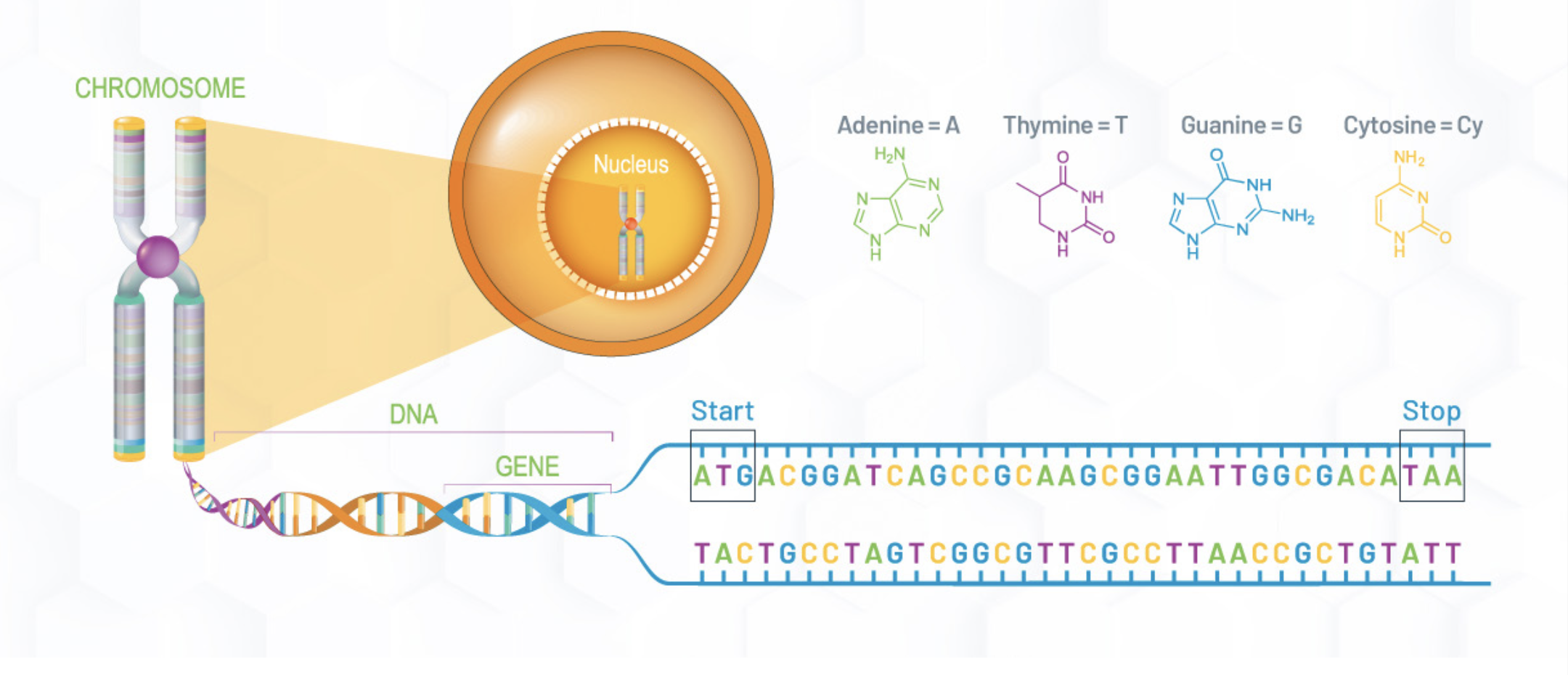
The phosphates and sugars are all practically identical in each nucleotide. So when it comes to analysis, the nitrogenous bases are the important part. They vary from nucleotide to nucleotide, being either Adenine (A), Guanine (G), Thymine (T), or Cytosine (C).
These nitrogenous bases make up the “code” of DNA, which means the order in which they sit on the nucleotide chain is very important.
The variation in all life, outward and inward, depends on the order of these bases along the double helix. Just a few differences in the “code” can have significant consequences for the cells, tissues, organs, or the entire bodily system. If the code is different enough—you are looking at a completely different species of organism.
DNA’s Structure and Storage
Part of what helps preserve the integrity of the DNA code is its double-helix structure.
Each “rung” on the ladder is made up of two nucleotides facing each other. The phosphates and sugars make up the two outer edges. And the two nitrogenous bases bond with each other in the middle.
The trick is, base pairs can only bond with each other according to a few simple rules: Adenine can only bond with Thymine, and Guanine can only bond with Cytosine, and visa versa. This way as long as one side of the double helix is preserved, its complementary other half can be correctly replicated whenever the need arises, maintaining perfect copies of your unique 3-billion digit code.
A gene—the portion of DNA code that correlates to a particular trait—can be made up of just a few base pairs or thousands of base pairs. And every human genome consists of more than 20,000 genes!
If you were to unwind all of the DNA from a single cell, a complete set of your genome, (the line would be microscopically thin, of course) it would reach about two meters. And yet all of that information can be packed into the nucleus of one microscopic cell! Although, it requires some serious Tetris skills.
Fortunately, the nucleus of each cell has special tools, special proteins called histones, that help the long, long DNA strands coil down into tight “chromatin” fibers. These fibers, in turn, make up your 23 pairs of chromosomes.

The Functional Role of DNA
Of course, for your DNA to be useful it can’t just sit there in its nicely packed little chromosomes and not do anything. Your body is constantly relying on your DNA for instructions, so that DNA has to be accessible in some way.
Whenever your DNA needs to be read for instructions a protein called helicase “unzips” a portion of the double helix and allows a polymerase to slip in and build a new complementary strand off of one side of the helix. This process is called transcription.
The resulting 1-sided strand of code is called mRNA and this is what travels outside of the cell nucleus to a protein-making factory called the “ribosome”. The ribosome reads the coded information that the mRNA transcripted from the DNA and uses it to build a protein.
Thousands of different proteins with different functions result from this process and are used to perform various tasks inside the body. Structural, antibody, transport, storage, and contractile proteins are all made by ribosomes reading strands of mRNA.
With trillions of cells in your body producing proteins every single day, your DNA truly is an active participant in your day-to-day life.
If you were to take and unravel all the DNA from the trillions of cells in your body, the length of it could cross our solar system twice! Suffice it to say, when it comes to your genome, you’ve got lots of backup copies.
Analyzing DNA
What Is The Benefit In Analyzing DNA?
Organisms have been unconsciously running on DNA instructions for millennia, but only within the last century has mankind begun to work directly with this incredible molecule.
So, what amazing things has mankind been able to do by consciously working with DNA?
1. Health & Wellness
As much as our DNA is meant to help us live a healthy life, some diseases find their root in our DNA. DNA analysis has identified the exact genes that cause or increase the likelihood of developing certain genetic diseases like cystic fibrosis, Huntington’s disease, certain cancers, and even type 1 diabetes.
Fortunately, knowing which genes can cause these diseases has allowed doctors to fight back with preemptive measures and sometimes with precision medicines (medicines that target disease-causing genes).
DNA analysis can even be helpful in supporting other, non-life-threatening, health conditions. Nutrigenetics, for example, studies your DNA to help you make smarter dietary choices for your genotype!
Since your DNA hardly changes throughout your lifetime, DNA analysis can provide individualized health information to you regardless of your age. Some DNA tests are even done prenatally to help parents prepare for, or even prevent, their child’s vulnerability to certain diseases or health issues.
See more about how iTOVi DNA can help you personalize your wellness in the last section of this blog.
2. Genealogical Studies
People are naturally curious about their ancestors— how they lived, where they came from, and what choices and events changed their family’s future. And research has shown that there are marked psychological benefits that come with knowing more about your family history.
Genealogical DNA analysis can analyze your DNA for genetic markers that have been passed down for many, many generations and then use those markers to create a readout of which ethnic groups your ancestors were a part of. But that’s not all! DNA ancestry analysis can analyze your Y chromosome to give you particular insight into your paternal line or your mitochondrial DNA to give you particular insight into your maternal line.
Sharing insights about your ancestors with your living family can have a powerful family-bonding effect, but learn- ing about your ancestors solely for your own benefit can be rewarding as well.
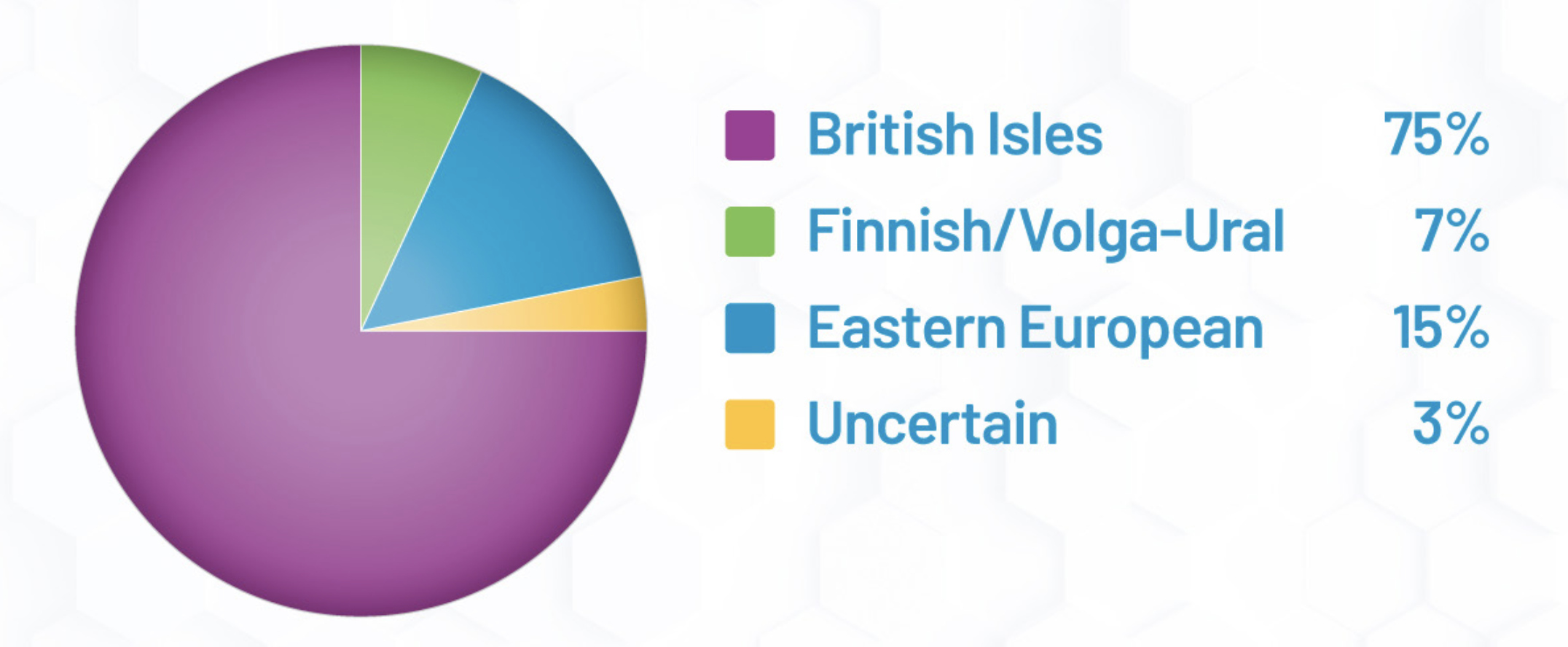
3. Genetic Engineering
Okay, before you start picturing science-fiction monsters and superheroes, remember that bio- technology and genetic engineering are far more regulated and safety-approved than you may think.
Genetic engineering is all about learning enough about genes to make helpful little tweaks to DNA, adding a gene here, cutting a gene there, all with the goal of creating a successful genetically-modified organism (GMO). GMOs can have many purposes, but we will cover a few of them here.
You’re probably most familiar with plant and animal GMOs—crops and livestock that have been genetically engineered for greater nutritional value, yield, and/ or tolerance to environmental stresses. Scientists have begun working with these GMOs in the hope that genetic engineering can help combat world hunger and increase global health.
You may be less familiar with the genetic engineering that produces insulin-producing bacteria, novel antibodies, life-saving vaccines, and gene-research models.
Experiments with genetic engineering even hope one day to save people from genetic disorders by re- placing or “knocking off” defective genes.
4. Forensics
After the completion of the Human Genome Project in 2003, scientists were able to determine what percentage of our DNA is unique to us as a species and how much of it is unique to each of us as individuals.
The results are rather surprising.
For example, the banana genome carries about 60% of the same genes as a typical human genome does. This isn’t to say that you are 60% banana—just that many of the fundamental building blocks of life are the same across different species and a small percentage of DNA variation can make an enormous difference in how an organism is built.
Each human has about 98% of their genes in common with certain ape species and 99% in common with all other humans!
That means that just 1% of your DNA makes you different from everybody else! Not only does that 1% make a huge difference for your body, but it also makes your DNA identifiable as uniquely yours.
In case you’re wondering, 1% of 3 billion base pairs is still 30 million base pairs, enough to make up thousands of genes. No wonder there is still so much variety in humankind with just a 1% difference in our genome!
Modern forensic DNA tests can get a full copy of a person’s genome from a very small DNA sample and then use that 1% difference in your DNA to create an individually-unique DNA profile. And when a DNA sample is taken from a crime scene or crime-related instrument, these tests can make a huge difference in detective work. DNA evidence alone is not considered to be enough to convict a person of a crime, but it certainly adds a lot of weight to criminal investigations and jury decisions.
How is DNA Analyzed?
What Are They Looking For?
When scientists analyze DNA they are usually looking for specific single-nucleotide polymorphisms (SNPs)—the most frequent type of variation in the genome.
A single SNP variation can make an important difference because having a Guanine-Cytosine pairing instead of an Adenine-Thymine pairing in just the right spot on your DNA code could be the difference between one hair color and another, whether or not you’ve inherited your father’s high metabolic utilization of protein, or even whether or not you will be susceptible to certain diseases in your life.
At first, of course, any variation from the norm in your genome would be considered a mutation, however, once the variation is present in at least 1% of the general population, it is considered to be an SNP. And there are over fifteen million significant SNPs in the human genome!
By tracking down the SNPs in your genome, researchers can determine what kind of alleles you have and therefore what genotype. And once your genotype is known, researchers can also determine the likelihood of that genotype’s trait manifesting in you.
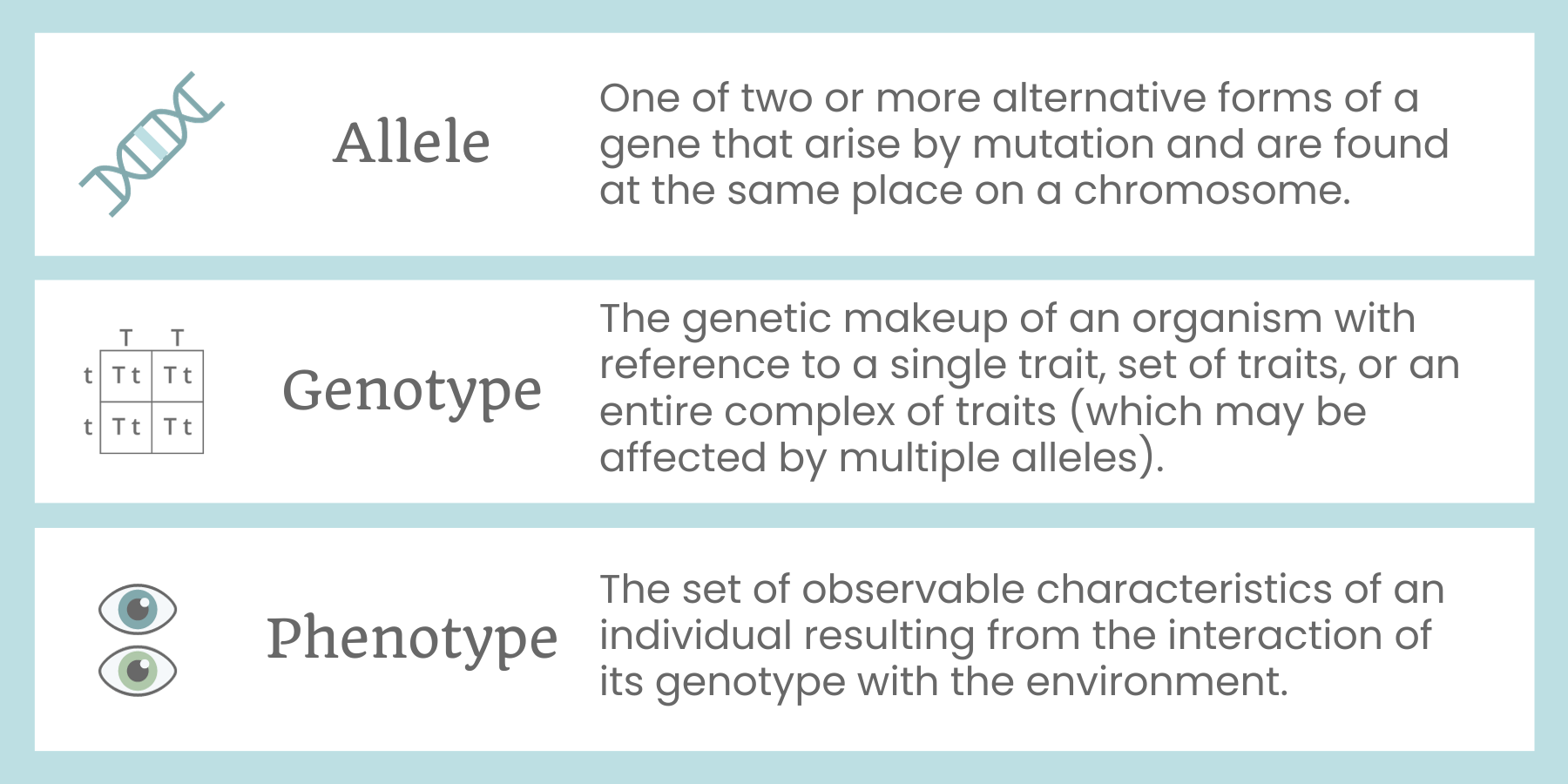
How is DNA Analysis Done?
So, how can modern technology and research methods identify the difference between the bases present in SNPs?
There are a number of different methods used for analyzing DNA and, of course, some are better for some applications than others. We’ll cover some of the most essential steps below as well as some of the finer details of forensic profiling and SNP array analysis.
Firstly, the DNA sample has to be collected through blood, saliva, hair, semen, or any other bit of biological material. DNA researchers then use enzyme solutions and mechanical disruption to break down both the cell membranes and the nucleus walls of the DNA sample in question. Once the DNA is free from the nucleus—likely floating about in a whitish-gooey form—it needs to be carefully purified and amplified before it is ready for analysis.
The DNA needs to be amplified because the individual nitrogenous bases that make up the SNPs are all about 8-10 atoms wide at most! That makes them pretty hard to pick out and analyze. So, most DNA analyzing projects use a method called Polymerase Chain Reaction (PCR) to make millions of copies of just the to-be-studied portion of a DNA sample. The process is remarkably similar to how mRNA is built within the cell.
All that is required is a little careful temperature manipulation to help the double helixes unwind, and then primers, little DNA fragments built to target a particular DNA region, are sent in to find and flank the section of DNA that the researchers want to analyze.
Once that is done, special polymerase proteins can build new complementary strands for the portion of DNA that extends between the primers. This way, rather than copying the entire genome, the polymerase proteins only make copies of the targeted DNA section. What happens next depends on the aim of your analysis.
DNA Forensic Profiling
If you are trying to create an individualized forensic profile, you would use PCR to find and amplify sections of DNA known as short-tandem repeat (STR) sections. These sections are useful for forensic profiling because everyone has these STR sections in their chromosomes, but the number of repeats, the length of the STR sections, can vary widely between individuals.
After the STR sections have been found and amplified, all the amplified DNA is placed into a gel tray and an electrical current is passed through the gel. This pulls the negatively-charged STR fragments through the gel towards the positive end of the gel tray and naturally, the smaller fragments get pulled farther, faster than the longer fragments. As a result, “bands” appear at different points along the gel track, indicating the length of the different STR sections from an individual’s DNA. This pattern of bands constitutes a DNA profile.
The United States Federal Bureau of Investigation has identified 13 specific STR loci to serve as the standard for forensic DNA analysis. The chances of your 13-fragment STR profile matching some- one else’s is about one in a billion, so DNA tests can place suspects at the scene of a crime with almost perfect certainty.
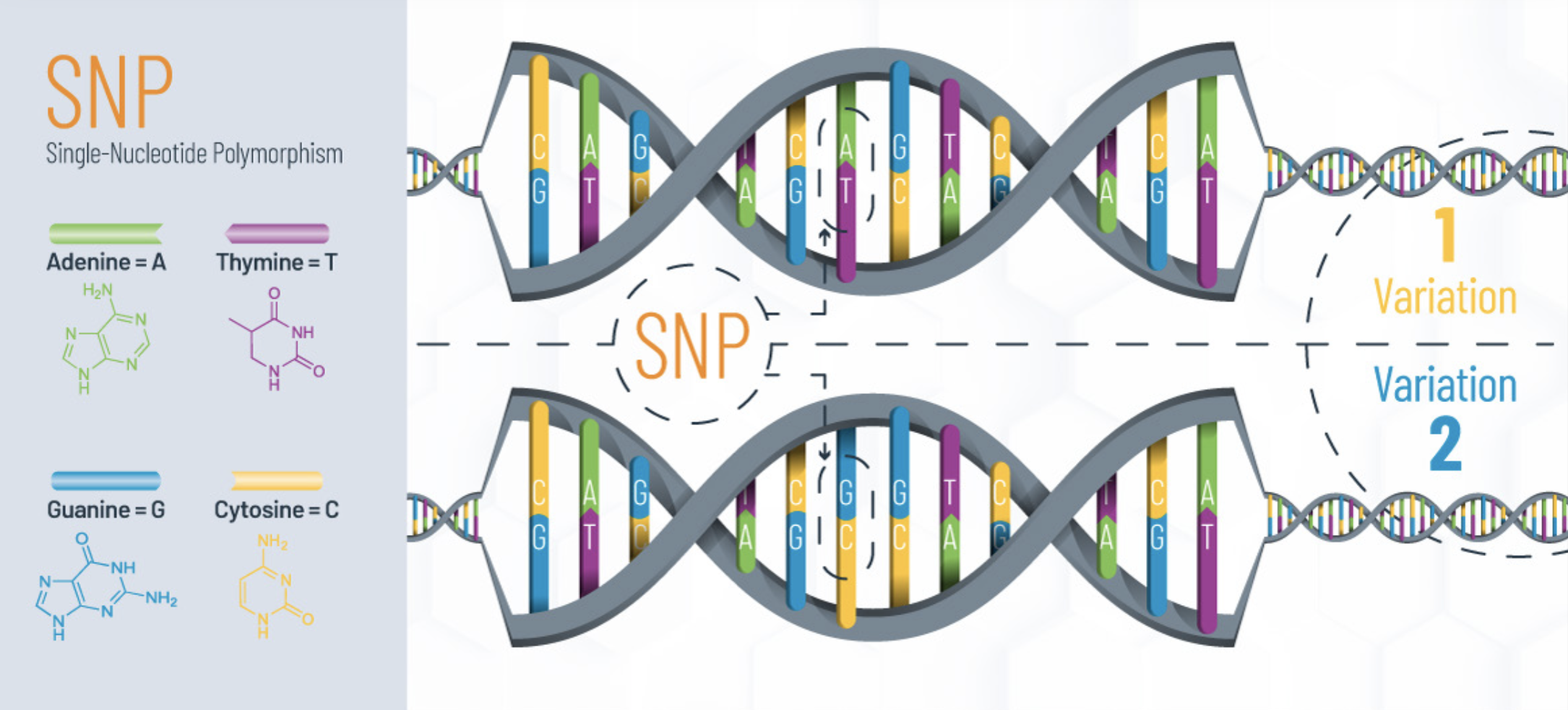
SNP Array Analysis
In studying specific SNPs, a common method is to use fluorescently tagged allele-specific oligonucleotides (ASOs). Much like the primers of PCR, these little pieces of synthetic DNA are built to seek out and bind to, or “hybridize” with, specific SNP sections. And to make them easier to work with later in the process, these ASOs are usually tagged with radioactive, enzymatic, or fluorescent labels.
What follows is a kind of process of elimination. Most SNPs are binary, so imagine, for the sake of explanation, that the fifth nitrogenous base pair on Variation 1 of a particular allele has a Guanine paired with a Cytosine and Variation 2 has an Adenine and a Thymine base pair in that same fifth spot.
In this case, finding out which allele variation is present in a particular individual’s DNA simply requires that you determine which of the two it isn’t. To find out, two differently-tagged ASOs are mixed into the PCR amplified DNA. The first ASO would be complementary to Variation 1 and for the sake of clarity, we’ll say it was tagged with fluorescent yellow. The second ASO would be complementary to Variation 2 and would be tagged with another color, say blue.
Even if the PCR process yielded some imperfect cop- ies of the original DNA strand, the majority of them would be perfect copies of either Variation 1 or Variation 2. So, whichever variation is present will have ample opportunity to bind itself strongly with the appropriate complementary ASOs. The ASOs that cannot find their complements may still bond with some of the PCR DNA fragments, but they will do so far less strongly than the better matched ASOs.
At this point, the bonded and un-bonded ASOs, and therefore the colored tags, would be mixed, show- ing a blend of colors. However, a delicate heat- ing and washing process will dismantle the more weakly-bonded, false pairs of PCR fragments and ASOs and then remove them, washing the mislead- ing color out of the array.
Laser-based scanning and computer software usually take care of the color-reading and determination of which SNP is present in the DNA sample.
In the earlier posited scenario, if the laser reads more yellow than blue in the array, it would serve as
a confirmation that the allele present in the DNA sample was Variation 1. If the laser picks up blue, it would mean that the sample DNA carried Variation 2 of the allele.
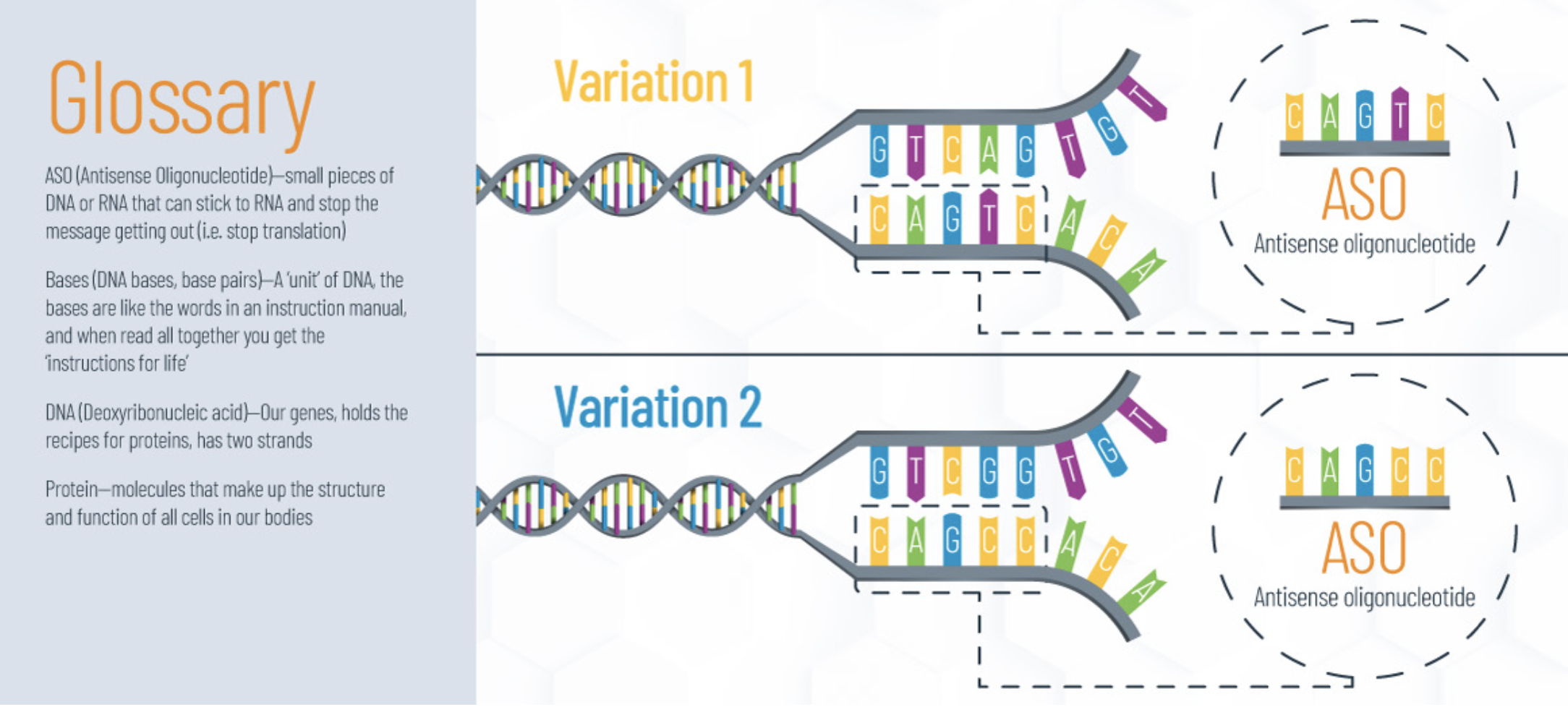
Conclusion
Unraveling the structure, function, and importance of DNA has been perhaps one of the most important contributors to man’s understanding of both individual and collective biology. Individualized DNA analysis has brought great sociological, psychological, medical, and wellness benefits to so many.
And while our DNA does not determine our destiny, understanding our DNA can help us change our futures for the better.
Glossary
Allele—One of two or more alternative forms of a gene that arise by mutation and are found at the same place on a chromosome.
ASOs—allele-specific oligonucleotides; tagged pieces of synthetic DNA used in SNP array analysis.
Chromosome—a threadlike structure of nucleic acids and protein found in the nucleus of most living cells, carrying genetic information in the form of genes.
DNA—deoxyribonucleic acid, a self-replicating material which is present in nearly all living organisms as the main constituent of chromosomes. It is the carrier of genetic information.
Helix—an object having a three-dimensional shape like that of a wire wound uniformly in a single layer around a cylinder or cone, as in a corkscrew or spiral staircase.
Double-Helix—a pair of parallel helices intertwined about a common axis.
Forensic—scientific tests or techniques used in connection with the detection of crime.
Gel electrophoresis— a technique used to separate DNA fragments according to their size.
Gene—a distinct sequence of nucleotides forming part of a chromosome, the order of which determines the order of monomers in a polypeptide or nucleic acid molecule; a unit of heredity which is transferred from a parent to offspring.
Genetic engineering—the deliberate modification of the characteristics of an organism by manipulating its genetic material.
Genetics—the study of heredity and the variation of inherited characteristics.
Genome—the complete set of genes or genetic material present in a cell or organism.
Genotype—is the collection of genes responsible for the various genetic traits of a given organism.
GMOs—genetically modified organisms; living organisms whose genetic material has been artificially manipulated in a laboratory through genetic engineering. This creates combinations of plant, animal, bacteria, and virus genes that do not occur in nature or through traditional crossbreeding methods.
Helicase—any of various enzymes that catalyze the unwinding and separation of double-stranded DNA or RNA during its replication.
Histones—a family of basic proteins that associate with DNA in the nucleus and help condense it into chromatin.
RNA—ribonucleic acid, a nucleic acid present in all living cells.
mRNA—a subtype of RNA that carries a portion of the DNA code to other parts of the cell for processing.
Nitrogenous bases—A molecule that contains nitrogen and has the chemical properties of a base. The nitrogenous bases in DNA are adenine (A), guanine (G), thymine (T), and cytosine (C).
Nucleotide—a compound consisting of a nucleoside linked to a phosphate group. Nucleotides form the basic structural unit of nucleic acids such as DNA.
Nutrigenetics—the heterogeneous response of gene variants to nutrients and dietary components.
Organism—a form of life composed of mutually interdependent parts that maintain various vital processes.
PCR—Polymerase chain reaction, or PCR, is a laboratory technique used to make multiple copies of a segment of DNA.
Phenotype—the set of observable characteristics of an individual resulting from the interaction of its genotype with the environment.
Ribosome—a complex molecular machine found inside the living cells that produce proteins.
Short-Tandem Repeat (STR) Analysis—a common molecular biology method used to compare allele repeats at specific loci in DNA between two or more samples. This method is often used in forensic analysis.
SNP—single-nucleotide polymorphism, these are the most common type of genetic variation among people. Each SNP represents a difference in a single nucleotide.
SNP array analysis—a type of DNA microarray which is used to detect polymorphisms within a population.

Sources
Dahm, Ralf. “Friedrich Miescher and the discovery of DNA” Developmental Biology. Volume 278, Issue 2, 15 February 2005, Pages 274-288. https://www.sciencedirect.com/science/article/pii/S0012160604008231
Foley, Mackenzie. “Genetics: Past, Present, and Future.” Dartmouth Undergraduate Journal of Science. Spring 2013 – 15th Anniversary Edition. https://sites.dartmouth.edu/dujs/2013/05/29/genetics-past-present-and-future/
Griffiths AJF, Miller JH, Suzuki DT, et al. An Introduction to Genetic Analysis. 7th edition. New York: W. H. Freeman; 2000. Historical development of the chromosome theory. Available from: https://www.ncbi.nlm.nih.gov/books/NBK22088/
Lima, Anna. “Family History and Genealogy: The Benefits for the Listener, the Storyteller and the Community.” Journal of Cape Verdean Studies. Volume 4, Issue 1. 2019. https://vc.bridgew.edu/cgi/viewcontent.cgi?article=1025&context=jcvs
McClean, Phil “A History of Genetics and Genomics.” September 2011. https://www.ndsu.edu/pub- web/~mcclean/plsc411/History-of-Genetics-and-Genomics-narrative-and-overheads.pdf
Sharma, Hari. “Ayurveda: Science of life, genetics, and epigenetics.” Ayu vol. 37,2 (2016): 87-91. doi:10.4103/ayu.AYU_220_16.
Trapezov, O.V. Mendel: Corroboration of the idea of binary trait coding by methods of statistical physics. Russ J Genet Appl Res 6, 15–25 (2016). https://doi.org/10.1134/S2079059716010159
Watson, James D., 1928-. The Double Helix : a Personal Account of the Discovery of the Structure of DNA. London :Weidenfeld and Nicolson, 1981.
“Combined DNA Index System (CODIS).” FBI. https://www.fbi.gov/services/laboratory/biomet- ric-analysis/codis
“History of the Human Genome Project.” Human Genome Project Information Archive 1990-2003.
https://web.ornl.gov/sci/techresources/Human_Genome/project/hgp.shtml
DNA Unraveled © 2020, İTOVİ




